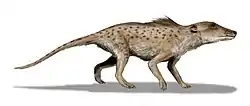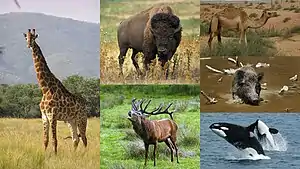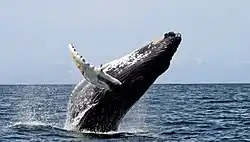鯨偶蹄目
鯨偶蹄目(学名:Cetartiodactyla)是一個包含了传统的鯨目及偶蹄目的演化支,一般用來描述鯨豚類是從偶蹄目中演化而來。遗传学分析表明,與鯨豚類親緣關係最近的現生動物是河馬。鯨與河馬的分支則稱為鯨河馬亞目(Whippomorpha,有建議使用 Cetancodonta 但未普及)。依此定义,剔除了鲸目的旧有偶蹄目将是一个并系群。
| 鲸偶蹄目 化石时期:55–0 Ma 始新世早期-现代
| |
|---|---|
 | |
| 巴基鯨是一種早期的鯨类。 | |
| 科学分类 | |
| 界: | 动物界 Animalia |
| 门: | 脊索动物门 Chordata |
| 纲: | 哺乳纲 Mammalia |
| 亚纲: | 兽亚纲 Theria |
| 下纲: | 真兽下纲 Eutheria |
| 演化支: | 胎盘类 Placentalia |
| 高目: | 北方真兽高目 Boreoeutheria |
| 总目: | 勞亞獸總目 Laurasiatheria |
| 目: | 鲸偶蹄目 Cetartiodactyla |
| 演化支 | |
在起初,鯨偶蹄類的定义原是指鯨目是偶蹄目的旁系姊妹分類,而非從偶蹄目演化。從此定義來看,所有偶蹄目(包括河馬)之間才是近親,而鯨是偶蹄类的旁系群。
鯨豚類演化自陸上的偶蹄動物,並形成了一個單系群。學界普遍認同鯨類是從單一的祖先演化而來。1990 年代以前,最廣泛接受的鯨類近親是已滅絕的中爪獸目。中爪獸目是有蹄的及主要是肉食性的哺乳動物。但現今很少學者認同這個說法,一般只認同中爪獸目是鯨偶蹄類的近親,而非鯨類的祖先。
相關研究
鯨類是從偶蹄目演化的理论是基於DNA序列的分析结果。在最初的分子分析中,顯示鯨類較豬更接近反芻亞目(如牛及鹿)。為了在目名反映這種演化關係,故出現了鯨偶蹄類。
後期的分子分析提供了更完整的線索。河馬被認為是鯨類的近親,反芻亞目與鯨/河馬的分支有關,而豬則被分類在更遠的位置。除了新增了鯨/河馬分支外,分析更顯示河馬及豬並非近親。這個結果很富爭議,因為傳統分類正有基於豬與河馬形態的相似而成立的豬形亞目。
除了DNA及蛋白質序列外,學者追蹤了基因組中一種稱為短散落配置(SINE)的轉位子。DNA序列的轉位子會有時將自己複製,並將複製品插入基因組的另一個位置。但 SINE 沒可能會將自己插入基因組的同一位置。數據顯示鯨魚、反芻亞目及河馬的基因組中,有幾個轉位子將自己插入同一位置上。在駱駝及豬的基因組中並沒有這個插入點。

不同的 DNA 序列測試都得出同一個結論:即河馬與鯨類非常接近,而和其他偶蹄目相對疏遠。這一點從鯨與河馬都可以利用超聲波在水中分辨敵友和在水中育兒(交配,產子和哺乳),以及陰嚢藏於腹腔内可以看出。
形態學及古生物學對鯨類與其他哺乳動物的關係亦於 1990 年代後出現很大變化。一些化石發現(如羅德侯鯨)顯示鯨類並非從中爪獸目衍生或與其是近親。很多学者支持成立鲸偶蹄目的分支,但也有部分學者反對鲸類與河马共祖的说法,认为三個亞目的傳統偶蹄目仍然是一个有效的分支,而四個亞目的鲸偶蹄类(即修正後的偶蹄目)则可能是一个大目或总目。
鯨/河馬学说认为鲸类与河马类在 6000 万年前拥有共同的半水栖祖先[1],直到 5400 万年前才分化成两支[2],其中一支演化成鲸类,可能始于巴基鲸及其他古鲸亚目近亲,它们渐渐适应水下生活,最后演化成完全水生的鲸类[3]。因此,此学说认为鲸偶蹄類才是有效的单系群分类。反對者的理由是,目前發現最早的河馬化石產生於中新世,而鯨類的分化則可上溯至始新世,鯨/河馬假說出現了一個 3000 萬年缺少河馬祖先存在的空白期。一些形態學研究指出石炭獸科是河馬的祖先,但卻得不到有力支持。
系統發生
根据近年的分子学研究,劳亚兽总目內部可能的演化关系如下(真有蹄类学说)[4]:
| 劳亚兽总目 Laurasiatheria |
| ||||||||||||||||||||||||||||||||||||
鲸偶蹄目各主要演化支的关系如下(鯨河马类学说):
| 鲸偶蹄目 Cetartiodactyla |
| ||||||||||||||||||||||||
參考文献
| 维基物种中的分类信息:鯨偶蹄目 |
- . Science News Daily. 2005-01-25 [2007-06-18]. (原始内容存档于2007-03-04).
- Ursing,B.M.; U. Arnason. . Proceedings of the Royal Society. 1998, 265 (1412): 2251–5. PMC 1689531. PMID 9881471. doi:10.1098/rspb.1998.0567.
- Boisserie, Jean-Renaud; Fabrice Lihoreau and Michel Brunet. . Proceedings of the National Academy of Sciences. February 2005, 102 (5): 1537–1541. PMC 547867. PMID 15677331. doi:10.1073/pnas.0409518102.
- Zhou, Xuming; Xu, Shixia; Xu, Junxiao; Chen, Bingyao; Zhou, Kaiya; Yang, Guang. . Systematic Biology. 2011, 61 (1): 150–164. PMC 3243735. PMID 21900649. doi:10.1093/sysbio/syr089.
延伸阅读
- Boissere, J.-R., F. Lihoreau, and M. Brunet. 2005. The position of Hippopotamidae within Cetartiodactyla. Proceedings of the National Academy of Sciences of the United States of America, 102:1537-1541.
- Gatesy, J. 1997. More support for a Cetacea / Hippopotamidae clade: The blood clotting protein gene g-fibrinogen. Molecular Biology and Evolution, 14:537-543.
- Gatesy, J., C. Hayashi, M. Cronin, and P. Arctander. 1996. Evidence from milk casein genes that cetaceans are close relatives of hippopotamid artiodactyls. Molecular Biology and Evolution, 13:954-963.
- Gatesy, J., C. Mathee. R. DeSalle, and C. Hayashi. 2002. Resolution of a supertree/supermatrix paradox. Systematic Biology, 51:652-664.
- Gatesy, J., M. Milinkovitch, V. Waddell, and M. Stanhope. 1999. Stability of cladistic relationships between Cetacea and higher-level artiodactyl taxa. Systematic Biology, 48:6-20.
- Grauer, D. and D. Higgins. 1994. Molecular evidence for the inclusion of cetaceans within the order Artiodactyla. Molecular Biology and Evolution, 11:357-364.
- Milinkovitch, M. C. and J. G. M. Thewissen. 1997. Even-toed fingerprints on whale ancestry. Nature, 388:622-624.
- Montgelard, C., F. Catzeflis, and E. Douzery. 1997. Phylogenetic relationships among cetartiodactyls and cetaceans as deduced from the comparison of cytochrome b and 12S RNA mitochondrial sequences. Molecular Biology and Evolution, 14:550-559.
- Naylor, G. J. P. and D. C. Adams. 2001. Are the fossil data really at odds with the molecular data? Morphological evidence for Cetartiodactyla phylogeny reexamined. Systematic Biology, 50:444-453.
- O'Leary, M. A. and J. H. Geisler. 1999. The position of Cetacea within Mammalia: phylogenetic analysis of morphological data from extinct and extant taxa. Systematic Biology, 48:455-490.
- Nikaido M, Rooney AP, Okada N (1999) Phylogenetic relationships among cetartiodactyls based on insertions of short and long interpersed elements: Hippopotamuses are the closest extant relatives of whales. Proc Natl Acad Sci U S A 96: 10261–10266.
- Shedlock, A. M., M. C. Milinkovitch, and N. Okada. 2000. SINE evolution, missing data, and the origin of whales. Systematic Biology, 49:808-816.
- Shimamura, M., H. Yasue, K. Ohshima, H. Abe, H. Kato, T. Kishiro, M. Goto, I. Munechika, and N. Okada. 1997. Molecular evidence from retroposons that whales form a clade within even-toed ungulates. Nature, 388:666-670.
- Thewissen, J. G., E. M. Williams, L. J. Roe, and S. T. Hussain. Skeletons of terrestrial cetaceans and the relationship of whales to artiodactyls. Nature, 413:277-281.


